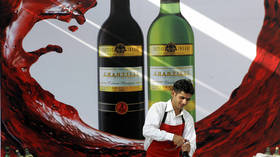Grape expectations: Why Indian drinkers are turning to wine like never before

The minerality of a terroir may mean nothing to them; they likely cannot tell oaky from herbaceous, or a Bordeaux from a Burgundy, but that has not stopped large numbers of Indians from taking to wine-drinking in recent years, at a speed that makes their country the toast of the world’s emerging wine markets. From 1 million liters in 2001, consumption of wine in India had grown to more than 34 million liters by 2021, a 3,300% rise over two decades.
Those numbers tell a story of transformation, not just of a wine-drinking culture taking root slowly but also of progress in wine-making and marketing in an industry not permitted to advertise.
Two trends are driving the boom in the Indian wine industry, according to Jayanth Bharathi from Fratelli Wines, which has made a splash with its premium wines and tourism offerings since 2011.
“Wine has been growing consistently over six to eight years as more Indians traveled abroad, got exposed to European culture, came across good wines and wine culture, and as Indian wines got better and better,” Bharathi said. Thanks to the Covid-19 pandemic, when drinking at home became more common, people started demanding better wines, he added. Choices at home veered toward wine on account of its slimmer social taboo. “Premium wine is the way to go, in a nutshell,” he said, “and education and awareness are aiding this.”
Among a handful of others, Fratelli is acknowledged as having led the finessing of wines produced in India. The view that Indian wines are typically inexpensive and of questionable quality has evolved as consumers came across quality offerings, while simultaneously beginning to understand wines better, Bharathi said.
A clear trend has emerged toward premiumization, but simultaneously a large market has emerged for ‘wine-based beverages’ such as wine-in-cans, coolers and sparklers, says Kiran Patil of Reveilo Wines. The label is part of Vintage Wines in Niphad, in the Nashik district of the western state of Maharashtra, home to India’s biggest wine-making hub.
Premium wines topline the current boom in the Indian wine sector. These are wines that Patil described as comparable in price point, quality and taste with good imported ones. At the lowest end of the spectrum, however, are large sales volumes from inexpensive and easy-to-drink wine-based beverages. These are blended, fortified, and with additives; and they are generally made from table grapes. Almost every wine manufacturer in India now has a brand in this category, clearly a mass segment nobody wants to miss out on.

“I wouldn’t even call them wines,” said Patil, who along with her husband Yatin gave up a corporate career to return to their ancestral farmland to develop vineyards nearly two decades ago. Reveilo, a boutique winery with a fully estate-bottled operation, was set up in 2005, and now produces premium wines including Italian varieties from rootstocks imported from Italy that year.
In fact, the Indian wine market is large enough for the purists and those promoting mass market brands. Less than 1% of alcohol consumed in India is wine, but Indians consume nearly 7 billion liters of alcohol annually, and 1%, or 70 million liters, is a sizable – and growing – market.
Better viniculture and more oenophiles
Growing dramatically since 2013-14, the quality of Indian wines has hit the sweet spot over the last two-three years, according to Ajit Balgi, a certified sommelier, wine and spirits educator and founder of The Happy High, a bartending academy.
“In the last two-three years, we have seen some fantastic Indian wines in the market,” Balgi said. Locally made brands on the higher side are priced at around Rs 4,000 ($50) a bottle. Among several brands in this category, Balgi lists Fratelli’s J’noon and Grover Zampa’s Signet. The latter is India’s first wine to be aged in foudres, amphoras and concrete tanks, while J’noon is made by master winemakers Piero Masi and Vrushal Kedhari, in tandem with exclusive blends crafted by French vintner Jean-Charles Boisset. “The new prowess of Indian wines can be seen in these,” said Balgi.
The traditional view of Indian wines being inexpensive and of poor quality no longer holds true, he said, as consumers, professionals, wine-makers and supply chains evolve and demand grows for better wines.
“It is the Indian wine scene that actually pushes consumers to try out foreign wines,” Balgi said, citing wine tourism as a major cause for this growth. “People who don’t drink have gone on wine tours, experienced their first wine, found that wine is perceived to be healthier, and that wine is not viewed as poorly as spirits or beer,” he added. Balgi notes that companies like Sula, which was a pioneer in the domestic mass market industry when it set up a winery in Nashik in 1999, have made it “so accessible, and so glamorous” to be seen with wine.
While India produces limited qualities of wine varietals of grapes on account of the hot growing conditions, those who have pleasant experiences with good Indian wines are then persuaded to try Australian, French, Spanish, Italian and other wines, now available at competitive prices.
The market’s spicy notes
Unlike in some parts of the West, wine is categorized as an alcoholic beverage in India, posing specific challenges to imports and retail, through wide variations in inter-state retail and taxation policies.
While the Indian wine market is valued at approximately $200 million with a 30% share belonging to imported wines, import-friendly policies and the consequent narrowing of prices between domestic and foreign wines is not great news for local manufacturers, particularly in states where local taxes are high. As prices of Indian wines rise with premiumization, consumers suddenly find foreign wines well within reach, for a mere Rs 200-Rs 300 ($2.40-$3.60) more. Balgi said wines from Chile and Argentina offer good quality at that price.

Indeed, wine imports have grown exponentially. For example, imports from Spain amounted to $1 million in 2022-23, and shot up to $58 million in the April-October 2023 period. In 2021, Australia was India’s largest source of wine imports, which grew 81% over the previous year. (This slowed in subsequent years along with a decline in Australian wine exports overall.)
Wine exporters looking at Indian drinkers as a lucrative growth opportunity are ready to innovate. In 2022, a Newcastle-based company launched a pinot noir and chardonnay in India with a trial that eyed customers looking for affordability and possibly consuming less at a time, offering a 375ml bottle.
High import tariffs have been eased somewhat for Australian wines in the wake of a trade deal concluded by the two countries. Additionally, as newly affordable foreign wines fill the shelves, wide inter-state variations in domestic taxation distort the playing field for Indian manufacturers.
Some states impose a very high tax on wines produced in a different state, rendering imported wine to be at par or lower priced than some domestic wines. “As winemakers, this is one of the things we are very interested in resolving, that Indian wines are not favored, and we raise this matter consistently with the industry body,” said Bharathi.
Wine remains an expensive choice in comparison to other alcoholic beverages, nearly twice the price of the inexpensive varieties of spirits and nearly three times the price of beer. The pricing restricts wine to being an urban phenomenon, limited to major Indian cities, with the boom led by youngsters entering the legal drinking age and finding ready-to-drink (RTD) wine beverages a convenient and hip option. Market surveys also found urban millennials to be the new wine consumers in India, concentrated in the top ten largest cities.
However, according to Balgi, there is a thirst for knowledge about quality wines beyond metro cities – in so-called ‘Tier 2’ towns like Guwahati, Dehradun or Lucknow, among others. These towns now have large-format liquor stores and customers curious about wine. “That is an offshoot of the Covid-19 trend of drinking at home, that young people also carried this lifestyle back home with them,” he said.
Battling the challenges

Climate change, meanwhile, presents significant challenges for Indian winemakers. The Nashik harvest is now rarely uniform, for example, and wineries have to make the adjustments in choices this requires.
Wine being an agriculture-based product, “dependent entirely on Mother Nature,” climate change and its impact on vineyards cannot be ignored any longer, Bharathi said, even though erratic rains have until now affected only a very small percentage of Fratelli’s yield, adding the company is “proactively” monitoring climate conditions on the yield.
The bigger challenge, however, for now, has been sales and distribution, said Patil of Reveilo, explaining that producers are saddled by different taxation rules in every state and mandatory renewals of licenses year after year, all expenditures that can only be justified by volumes. This skewed demand-supply dynamic poses a big challenge to small wineries. For companies like hers that produce neither low-end wine nor wine-based beverages, it becomes a restrictive playing field.
Industry experts believe the opportunity for rapid growth in India is huge, provided manufacturers can reach wider domestic markets. Reflecting a trend witnessed in India and globally, at sales fairs, Reveilo’s more expensive offerings sell the most – evidence of maturing domestic buyers. “Even those not articulate in wine jargon who may not recognize a dry wine or oak flavors are enjoying the premium wines,” Patil said. “The Indian wine consumer has most certainly evolved.”














